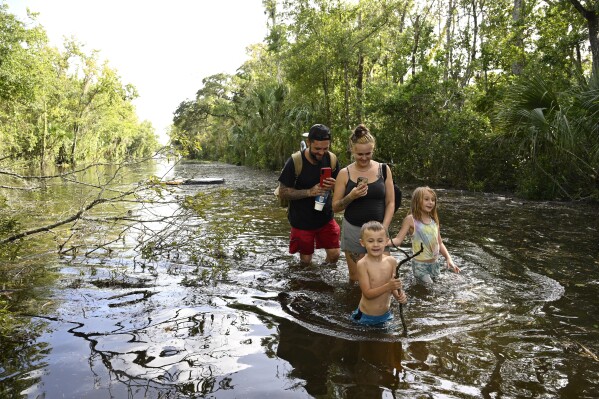As it happened: Helene claims at least 40 lives as rescuers race to free those trapped by the storm

Vice President Kamala Harris on Friday urged residents impacted by Hurricane Helene to pay heed to local authorities as the storm continues to wreak havoc on a significant swath of the southeast.
“The storm continues to be dangerous and deadly, and lives have been lost and the risk of flooding still remains high,” Harris said at the start of a campaign speech in Douglas, Arizona. “So, I continue to urge everyone to please continue to follow guidance from your local officials until we get past this moment.”
Electric vehicles can catch fire if they are inundated by saltwater, so owners who live in the path of a major storm like Hurricane Helene should take precautions.
The National Highway Traffic Safety Administration has been researching this problem since it was first seen after Hurricane Sandy struck the Northeast in 2012. But no one seems to have detailed statistics on just how often this happens.
Two years ago, Hurricane Ian compromised the batteries of as may as 5,000 electric vehicles, and 36 of them caught fire. Several more electric vehicles caught fire in Florida last year after Hurricane Idalia.
It happens often enough that Florida officials were worried about the possibility before Hurricane Helene arrived because they were expecting a potentially devastating storm surge up to 20 feet deep in the northwestern part of Florida.
These fires do seem to be linked specifically to saltwater because salt can conduct electricity. Similar problems haven’t been reported after freshwater flooding in California that was driven by heavy rains early this year.
A weather TV reporter in Atlanta interrupted his live report about Hurricane Helene on Friday to rescue a woman from a vehicle stranded by rising floodwaters.
Standing in the rain with the submerged vehicle behind him, Fox reporter Bob Van Dillen described how the woman drove into a flooded area.
In the footage, he said he called 911 and she can be heard screaming as he tries to assure her that help was on the way.
Then, he told the camera, “It’s a situation. We’ll get back to you in a little bit. I’m going to see if I can help this lady out a little bit more you guys.”
The death toll from Hurricane Helene in South Carolina is 19 people, with many of the deaths happening from falling trees as the storm moved through early Friday, authorities said.
In Saluda County, two firefighters were killed when a tree fell on their truck while they were answering a call, the Highway Patrol said.
Five people were killed in Spartanburg County, according to Coroner Rusty Clevenger who planned to release details about the deaths later.
In Greenville County, four people were killed by falling trees, Senior Deputy Coroner Shelton England said.
Four people were also killed in Aiken County by trees falling on homes, including a 78-year-old husband and his 74-year-old wife, Coroner Darryl Ables said.
Two people died in Anderson County when trees fell on their houses, the Coroner’s Office said.
And in Newberry County, a married couple died when their car slid on a wet highway and ran into a tree, Coroner Laura Kneece said.
Helene is the deadliest tropical storm in South Carolina since Hurricane Hugo killed 35 people when it came ashore just north of Charleston in 1989.
Recent major hurricanes that made landfall in the U.S. have left hundreds dead and caused billions of dollars in damages.
Since 2020, not including Helene, there have been seven major destructive hurricanes: Laura, Delta, Zeta, Ida, Ian, Idalia and Beryl.
Hurricane Beryl was the first of the 2024 Atlantic hurricane season, according to the National Oceanic and Atmospheric Administration. Exceptionally warm ocean temperatures caused it to strengthen into a Category 5 storm rapidly in early July.
When hurricane Beryl hit Texas, it had dropped to a Category 1 storm. Beryl has been blamed for at least 36 deaths. The storm caused an estimated $28 billion to $32 billion in damages, according to AccuWeather’s preliminary estimates.
The windswept beauty of what residents claim is one of Florida’s longest stretches of undeveloped coastline was left deeply scarred after Hurricane Helene crashed ashore in rural Taylor County along the state’s Big Bend.
It’s a part of the state where salt marshes and pine flatwoods stretch unspoiled into the horizon, a region that has largely avoided the crush of condo developments, strip malls and souvenir shops that has carved up so much of Florida’s coastlines. It’s a place where Susan Sauls Hartway and her four-year-old Chihuahua mix Lucy could afford to live within walking distance of the beach on her salary as a housekeeper.
At least until her home was carried away by Helene.
“I knew it would be bad, but I had no idea it was going to be this bad,” she said. “This is unbelievable.”
Friday afternoon, Hartway and Lucy wandered around their street near Ezell Beach, searching for where the storm may have deposited her home.
“It’s gone. I don’t know where it’s at. I can’t find it,” she said.
Born and raised in Taylor County, Hartway said there is nowhere in the world she would rather be, even after Helene. But she’s watched as wealthier residents from out of state have bought up second homes here. She wonders how many of them will sell out — and what will happen to the locals who have nowhere else to go.
“There’s so many people down here, they don’t have any place to go now. This was all they had,” Hartway said. “Some people, they’ll just make do down here. Rough it.”
The windswept beauty of what residents claim is one of Florida’s longest stretches of undeveloped coastline was left deeply scarred after Hurricane Helene crashed ashore in rural Taylor County along the state’s Big Bend.
It’s a part of the state where salt marshes and pine flatwoods stretch unspoiled into the horizon, a region that has largely avoided the crush of condo developments, strip malls and souvenir shops that has carved up so much of Florida’s coastlines. It’s a place where Susan Sauls Hartway and her four-year-old Chihuahua mix Lucy could afford to live within walking distance of the beach on her salary as a housekeeper.
At least until her home was carried away by Helene.
“I knew it would be bad, but I had no idea it was going to be this bad,” she said. “This is unbelievable.”
Friday afternoon, Hartway and Lucy wandered around their street near Ezell Beach, searching for where the storm may have deposited her home.
“It’s gone. I don’t know where it’s at. I can’t find it,” she said.
Born and raised in Taylor County, Hartway said there is nowhere in the world she would rather be, even after Helene. But she’s watched as wealthier residents from out of state have bought up second homes here. She wonders how many of them will sell out — and what will happen to the locals who have nowhere else to go.
“There’s so many people down here, they don’t have any place to go now. This was all they had,” Hartway said. “Some people, they’ll just make do down here. Rough it.”
Be the first to comment